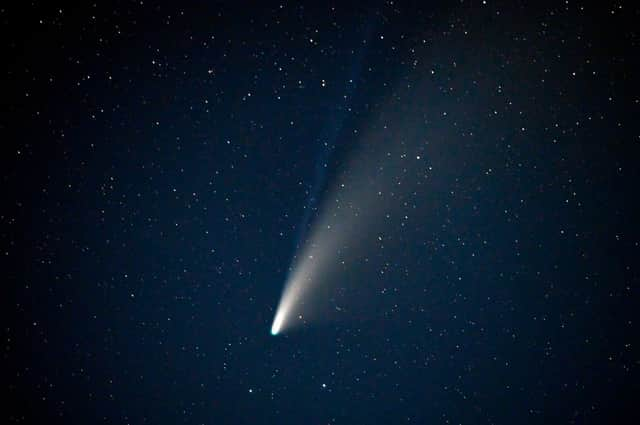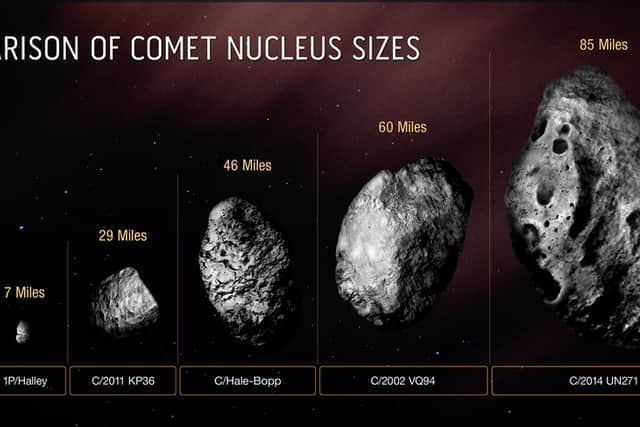Is a comet heading to Earth? How big is Bernardinelli-Bernstein, how far away is it and should we be worried


Ever since the release of Don’t Look Up - Adam McKay’s humourous Oscar-nominated drama about a team of scientists who discover a planet-killing comet heading towards Earth - interest in the icy celestial bodies has been at a high.
Though that film was fictional, could such a space rock bring about an end to life on Earth as we know it, and are there any comets floating about that we should be aware about right now?
Advertisement
Hide AdAdvertisement
Hide AdWith that in mind, it might be a little unnerving to hear that Nasa recently reevaluated an already known specimen, revealing it to be 50 times bigger than your average comet.
It’s the biggest comet ever observed. Oh, and it’s also travelling towards the centre of our Solar System at 22,000 miles per hour.
So should we be worried?
Here’s everything you need to know.
How big is the comet?
The catchily named C/2014 UN271 (Bernardinelli-Bernstein) has been found to measure over 80 miles in diameter.
That’s 50 times bigger than an average comet, and is thought to weigh 500 trillion tonnes; that’s a 100,000 times more massive than the typical comet usually found closer to the Sun.
Advertisement
Hide AdAdvertisement
Hide AdIt’s a record breaking rock, and is the largest such object ever glimpsed.
For comparison’s sake, the asteroid that is thought to have wiped out the dinosaurs was only around six miles wide.
How was it discovered?


C/2014 UN271 is not actually a new discovery, and has been on scientists’ radars since late-2010 - at that point in time, it was much further away from Earth than it is now.
Although researchers knew the comet had to be larger than average - thanks to it being so active for how far out from the Sun it was - they weren’t able to get a good look at it.
Advertisement
Hide AdAdvertisement
Hide AdBut since the comet is now closer to us, astronomers have used images taken by the Hubble Telescope to calculate the comet’s size more accurately.
Comparing five images taken by the space telescope earlier this year, and using computer modelling to clear up the grainy images, scientists determined that the solid icy centre of comet C/2014 UN271 measures 80 miles across.
Should we be worried?
Of course, were an object of such size to crash into Earth, it would almost certainly wipe out all life on our planet, being over 10 times larger than the asteroid that caused the extinction of the dinosaur.
So should we start getting our affairs in order?
No. There is absolutely nothing to worry about with comet C/2014 UN271.
Advertisement
Hide AdAdvertisement
Hide Ad‘Near misses’ with newly discovered space rocks are common, and even then, the word ‘near’ is relative in space terms, usually referring to anything that passes closer to Earth than our planet is to the Sun. Or within 93 million miles.
But C/2014 UN271 won’t even be a near miss.
Yes, the object is “barreling” towards the centre of our Solar System (Nasa’s own words), but it is predicted that the comet will get no closer to the Sun than 1 billion miles.
That’s further than the distance at which Saturn orbits our star, and even then, that’s not predicted to happen until 2031.
Where did the comet come from?
C/2014 UN271 has been falling toward the Sun for well over a million years., and is thought to have originated in the hypothesised nesting ground of trillions of comets called the Oort Cloud.
Advertisement
Hide AdAdvertisement
Hide AdThough projections suggest that the Oort Cloud could be located as far as 466 billion miles from our Sun, it is thought to have actually formed much closer, eventually being thrown out to the outer reaches of the Solar System by the formation of large planets like Jupiter.
The Cloud and its contents - like C/2014 UN271 - are billions of years old.
How can I see it?
Unfortunately, despite its massive size, the comet will not be readily visible from Earth.
The best places to see it will be from the southern hemisphere, and even then, a fairly powerful telescope will be needed to viewer it, the sort most hoobysists aren’t likely to have access too.
Advertisement
Hide AdAdvertisement
Hide AdSince the comet came closer, scientists have also determined that it is much duller than previously thought, with a surface described as “blacker than coal”.
This makes it harder to see than most comets, which can reflect a good deal of sunlight back from their icy surfaces.
Comment Guidelines
National World encourages reader discussion on our stories. User feedback, insights and back-and-forth exchanges add a rich layer of context to reporting. Please review our Community Guidelines before commenting.
